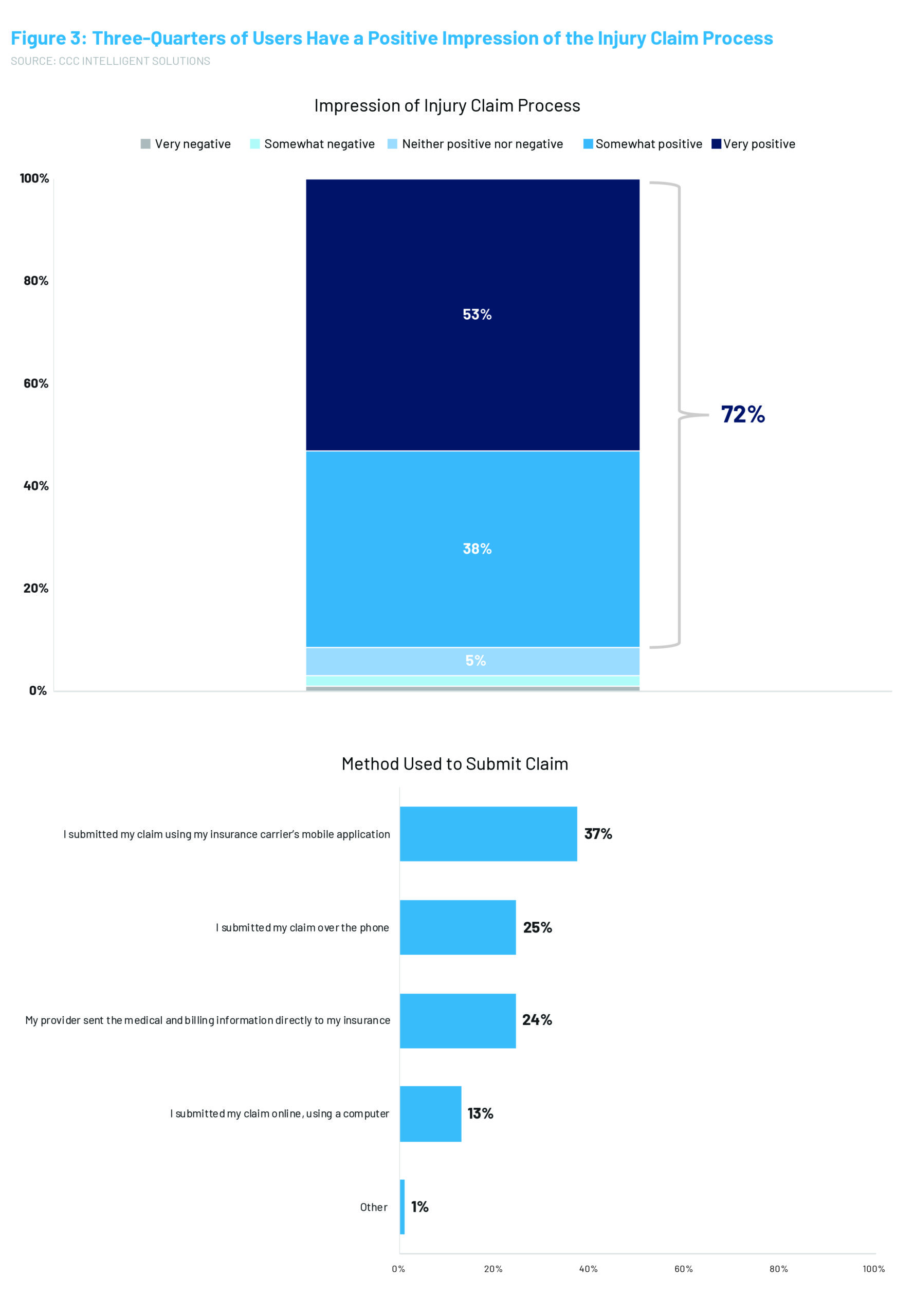It’s no secret that the insurance industry is shifting to increased digital engagement with consumers to streamline the claims process. The innovation shift has accelerated in the post-pandemic landscape along with the desire to inject AI and automation into as many steps as possible. This urgency has further compounded with recent volatility including rising medical costs and increased adjuster turnover. Insurers feel the pressure to innovate quickly to keep up with the expectations of an increasingly tech-savvy and demanding consumer base. Much has been written about recent progress of this shift in the auto physical damage and collision repair process in the most recent edition of Crash Course.Additionally, according to the latest JD Power & Associates Auto Claims Satisfaction Study, speed matters: Customer experiences with the fastest cycle time to resolution and the least claim representative interaction yielded the highest customer satisfaction scores. Consumers are increasingly willing to engage with insurers and repair shops via their preferred mobile/digital channels, especially if it cuts down the number of interactions and reduces cycle time to resolution and payment.On the casualty side of the claims process, much less has been written and/or tested. Are consumers as willing to engage in the claims process via digital/mobile channels for injury claims as they are for auto physical damage? As an industry leader in innovation, CCC has been putting this question to the test not only from a research standpoint but by deploying industry-leading casualty mobile solutions.Consumer Study Key FindingsCCC recently commissioned an independent study to examine attitudes towards digital engagement on casualty claims. The sample was comprised of more than 500 drivers who have recently (within the last 2 years) been involved in a low impact collision with a minor injury claim (less than 10K) with a top 30 carrier. The drivers were surveyed with key findings as follows:
- Most respondents (91%) used a mobile app during the claims process. The most common reason for not using the mobile option was lack of advertising/awareness (i.e. the customer did not know the solution existed.)

- Most respondents were relatively new to using this method of engagement with more than half (55%) using the app for the first time.
- Most respondents also found the mobile application easy to use.

Now let’s pivot to the casualty-specific findings:
- Most respondents had a positive impression of the claims process.

- Most respondents are comfortable sharing all types of info with their carrier.

- Most medical claims resolved within a week, often within a couple of days.

- Most respondents were willing to use mobile payment if it simplified and/or sped up the claim process, with the older age segment (35+) surprisingly even more willing than the younger segment (18-34).

The results are encouraging for those carriers willing to engage customers and third-party injured parties via digital channels. Findings track with similar auto physical damage results emphasizing ease of use, limited number of interactions, time savings, and ease of resolution/payment. Based on this, one key recommendation to insurers would be to focus on advertising and educating the consumer on both the availability and efficiency of this method of engagement.Recovery Assistant Early IndicatorsIt makes sense that policyholders would typically be more comfortable sharing personal and/or medical information with their own carrier, but does this willingness to engage and share information via digital channels translate to third-party bodily injury claims? Always willing to innovate, CCC has put that question to the test in the real world via our new Recovery Assistant solution which launched in Q3 of 2021.Claim adjusters leverage the online portal to send a text or email invite to engage third-party injury claimants. The claimant uses the same portal to provide information and/or submit proofs such as medical bills and wage verification. The adjuster will then evaluate the claim based on the information received from the injured party to determine a fair and appropriate claim resolution. If warranted, a settlement offer can be extended digitally and negotiated as necessary. Early production results have been both exciting and encouraging; adjusters have now successfully settled claims completely digitally. Cycle times from initial contact to settlement resolution were notably improved, and negotiations beyond the initial offer were minimal. Both text and email proved effective methods of engagement, which supports similar industry findings stressing need to engage customers via their preferred channel.It’s well-established that longer cycle times on third-party casualty claims correlate with larger payouts. When minor injury opportunities are identified via early triage, it’s imperative to engage with increasingly tech-savvy claimants in a way that is simple and efficient, thereby benefiting both the insurer and the claimant. Consumers have shown a willingness to engage and resolve casualty claims via digital channels both through survey and real-world results.The Recovery Assistant application comprises one component of the overall CCC strategy to streamline the casualty claims process via AI, automation, and digitization. To schedule a demo and/or request more information about this content or CCC products, please reach out to your CCC account representative.
It’s no secret that the insurance industry is shifting to increased digital engagement with consumers to streamline the claims process. The innovation shift has accelerated in the post-pandemic landscape along with the desire to inject AI and automation into as many steps as possible. This urgency has further compounded with recent volatility including rising medical costs and increased adjuster turnover. Insurers feel the pressure to innovate quickly to keep up with the expectations of an increasingly tech-savvy and demanding consumer base. Much has been written about recent progress of this shift in the auto physical damage and collision repair process in the most recent edition of Crash Course.Additionally, according to the latest JD Power & Associates Auto Claims Satisfaction Study, speed matters: Customer experiences with the fastest cycle time to resolution and the least claim representative interaction yielded the highest customer satisfaction scores. Consumers are increasingly willing to engage with insurers and repair shops via their preferred mobile/digital channels, especially if it cuts down the number of interactions and reduces cycle time to resolution and payment.On the casualty side of the claims process, much less has been written and/or tested. Are consumers as willing to engage in the claims process via digital/mobile channels for injury claims as they are for auto physical damage? As an industry leader in innovation, CCC has been putting this question to the test not only from a research standpoint but by deploying industry-leading casualty mobile solutions.Consumer Study Key FindingsCCC recently commissioned an independent study to examine attitudes towards digital engagement on casualty claims. The sample was comprised of more than 500 drivers who have recently (within the last 2 years) been involved in a low impact collision with a minor injury claim (less than 10K) with a top 30 carrier. The drivers were surveyed with key findings as follows:
- Most respondents (91%) used a mobile app during the claims process. The most common reason for not using the mobile option was lack of advertising/awareness (i.e. the customer did not know the solution existed.)

- Most respondents were relatively new to using this method of engagement with more than half (55%) using the app for the first time.
- Most respondents also found the mobile application easy to use.

Now let’s pivot to the casualty-specific findings:
- Most respondents had a positive impression of the claims process.

- Most respondents are comfortable sharing all types of info with their carrier.

- Most medical claims resolved within a week, often within a couple of days.

- Most respondents were willing to use mobile payment if it simplified and/or sped up the claim process, with the older age segment (35+) surprisingly even more willing than the younger segment (18-34).

The results are encouraging for those carriers willing to engage customers and third-party injured parties via digital channels. Findings track with similar auto physical damage results emphasizing ease of use, limited number of interactions, time savings, and ease of resolution/payment. Based on this, one key recommendation to insurers would be to focus on advertising and educating the consumer on both the availability and efficiency of this method of engagement.Recovery Assistant Early IndicatorsIt makes sense that policyholders would typically be more comfortable sharing personal and/or medical information with their own carrier, but does this willingness to engage and share information via digital channels translate to third-party bodily injury claims? Always willing to innovate, CCC has put that question to the test in the real world via our new Recovery Assistant solution which launched in Q3 of 2021.Claim adjusters leverage the online portal to send a text or email invite to engage third-party injury claimants. The claimant uses the same portal to provide information and/or submit proofs such as medical bills and wage verification. The adjuster will then evaluate the claim based on the information received from the injured party to determine a fair and appropriate claim resolution. If warranted, a settlement offer can be extended digitally and negotiated as necessary. Early production results have been both exciting and encouraging; adjusters have now successfully settled claims completely digitally. Cycle times from initial contact to settlement resolution were notably improved, and negotiations beyond the initial offer were minimal. Both text and email proved effective methods of engagement, which supports similar industry findings stressing need to engage customers via their preferred channel.It’s well-established that longer cycle times on third-party casualty claims correlate with larger payouts. When minor injury opportunities are identified via early triage, it’s imperative to engage with increasingly tech-savvy claimants in a way that is simple and efficient, thereby benefiting both the insurer and the claimant. Consumers have shown a willingness to engage and resolve casualty claims via digital channels both through survey and real-world results.The Recovery Assistant application comprises one component of the overall CCC strategy to streamline the casualty claims process via AI, automation, and digitization. To schedule a demo and/or request more information about this content or CCC products, please reach out to your CCC account representative.




